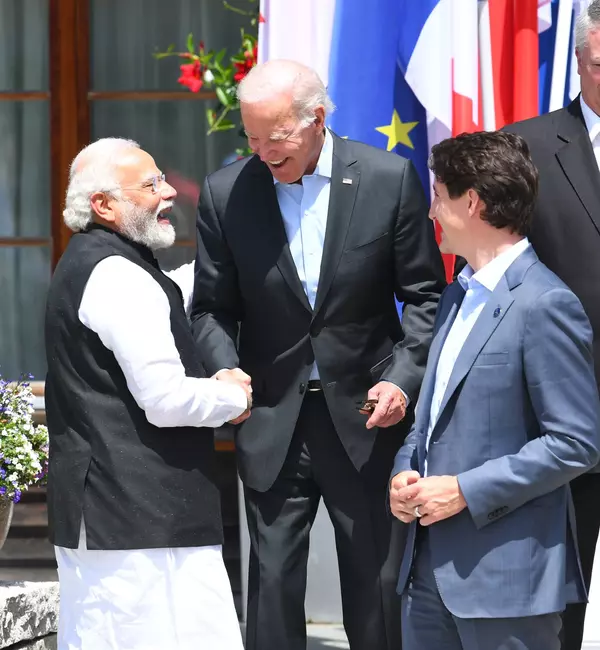By Vivek Mishra
Two important global events which took place within a week of each other this month: the G7 and the virtually held BRICS summit represent a microcosm of the trends reshaping global geopolitics.
The recently concluded G7 meet in Germany and the virtually held 14th BRICS summit evince why the West may be adapting to accommodate the global South, particularly India, at a time when the chinks in the armour of both BRICS and the G7 are glaring. While the BRICS faces an elusive unified position on issues with both subtle and stark differences between member countries on various issues including counterterrorism, the G7 has diminishing influence in the global south. These trends have intensified in the face of lingering pandemic-induced disruptions and the ongoing Russia-Ukraine war. Straddling both major multilateral organizations places India stands at a unique vantage point, bridging the necessities of the global South with the compulsions of the global north.
The post pandemic disruptions in supply chains and an active combat situation in eastern Europe have upended strategic realities for the West. The G7’s oft-cited criticism of it being akin to an old boys’ club which may not be as effective is perhaps standing the test of time in the rather limited impact of Western sanctions on Russia. The ability of Russia to keep the war going, while making tactical gains in eastern Europe, has generated compulsions for the West to engage the global South, particularly India. In its market potential and as a stable democratic anchor, New Delhi stands out. Europe’s decision to reroute its energy demands from Russia and the possibility of an emerging Russia-China-Iran axis have together contributed to this year’s G7 agenda: integration of key global south countries.
The G7’s invitation to the four countries outside the informal group of seven most industrialised nations; Senegal, South Africa, India and Indonesia, represents critical nodes in the expanded Indo-Pacific region which could lead to the formation of an important supply chain network circuit. Indonesia in the Pacific theatre, India in the Indian Ocean, South Africa straddling the Indian and the Atlantic Oceans, and Senegal in the Atlantic Ocean could be the principal hubs of shipping and supply chains to sustain a future Indo-Pacific architecture, which is expansive and inclusive.
While the ongoing Russia-Ukraine war may have been an immediate setting for the G7 countries, a resilient and expansive economic linkage to the Indo-Pacific is perhaps as important in the light of the West’s strategic and economic goals in this region. Coming on the heels of the recently launched Indo-Pacific Economic Framework, the effort seeks to create an economic network to sustain economic initiatives, create alternatives for smaller nations and maintain a favourable balance of power in the region.
Within the current dynamic in the Indo-Pacific region, the Chinese BRI dominates infrastructure financing by way of providing easy, albeit extractive, loans. As such, the democratic credentials underpinning the Indo-Pacific initiatives in the region aspires to create alternatives for countries to be able to choose freely when it comes to sourcing finance for infrastructure and other needs.
The supply of energy and trade connectivity with Asia have gained further salience for the West in the light of the disruptive constraints imposed by an active conflict in Europe. This realization is undergirded by the post-pandemic realization that concentration of supply chains in any one country or region may lead to long lasting disruptions for the rest of the world. As a result we have seen a host of a host of economic-strategic initiatives by the West, particularly led by the US, aiming to not just establish predictable supply chains but a regional collective seeking to maintain a favourable balance of power in the Indo-Pacific region. The reference point, of course, is China which is speeding ahead in this region in terms of building naval power and driving economic stakes.
At the strategic level, the US decision to launch the Partnership for Global Infrastructure and Investment (PGII) at this year’s G7 summit is in the same direction. Building further on the launch of the IPEF, the PGII has sought to “ deliver game-changing projects to close the infrastructure gap in developing countries, strengthen the global economy and supply chains, and advance U.S. national security.”
India’s participation in both the major global events showcased opportunities and challenges ahead. While the BRICS summit showed that differences persist between group members on issues of counterterrorism and global governance, the G7 provided a credible platform to realign some priorities for India in the light of strategic compulsions and changing priorities as a result of the Russia-Ukraine war.
India’s rising economic profile and a resilient economy have ensured that it is now a regular invitee to the G7 summits.
However, India should avoid the ‘G8 trap’ for now, even if a formal invitation to join the G7 may become a reality in the near future. Since 2014, when Russia was evicted from the grouping, the G8 has functioned as G7. The Russia-Ukraine war may have created compulsions on the West to co-opt India in the group. It will serve New Delhi’s interests better if its Indo-Pacific commitments are kept distinct from a collective western agenda that may not serve its own interests. In steering clear of the doubling-down sanctions on Russia imposed during the G7 meet in Germany, India did just that.
Also Read: PM Modi stresses need for talks to end Ukraine conflict in bilateral meetings at G7 summit
Also read: WATCH: US President Joe Biden’s special regard for PM Modi at G7 meet




















